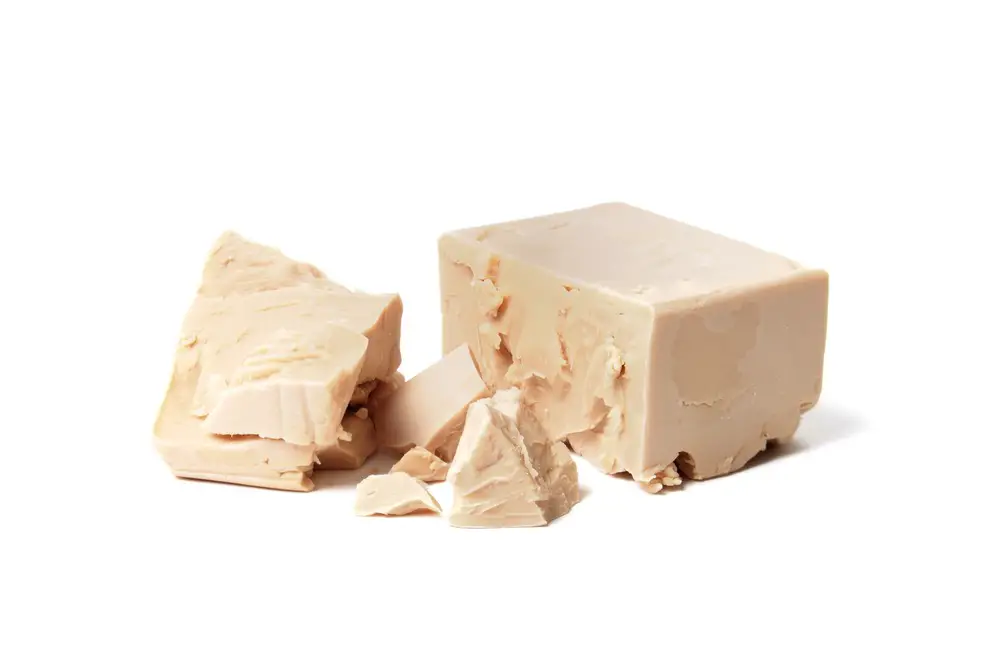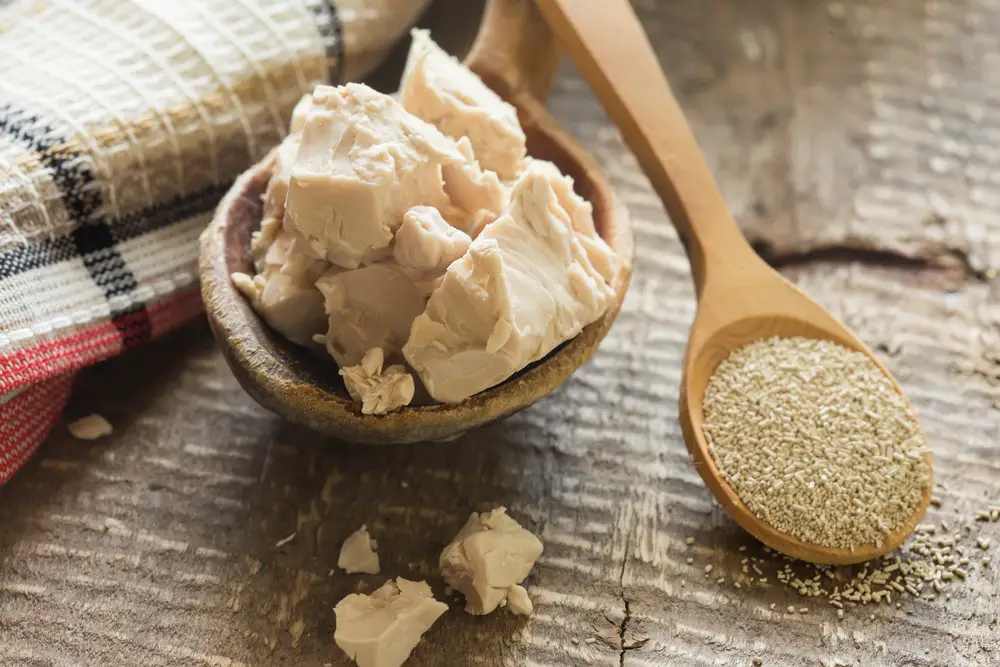Vegans avoid all animal products and foods containing them. Yeast is technically alive, but the fungi used in bread and beer production is a single-celled organism that often leads to confusion about whether it can be categorized as vegan.
In this article, we look for the answer to the question: Is Yeast Vegan? To do so, we must explore the various forms of yeast and if the products made with it can be considered vegan.
What is yeast, and what are its uses?
Yeast is a single-celled fungus that’s part of the mushroom family. It grows on the surface of soil and plants. Some strains of the fungus are harmful to people, but others have several benefits. Saccharomyces cerevisiae is the most common strain of this microscopic member fungus family member used in foods.
Several foods contain yeast for fermentation and leavening purposes because, when activated, it metabolizes into energy. For example, its primary uses are for bread, bead, and winemaking. Its addition to foods like cheeses helps improve their flavor or texture. Its use has continued unabated for over five millennia.
Some types of yeast help to fortify the value of foods because it’s rich in several vitamins, including vitamin B.
Yeast has other typical uses: it’s often a medium used for researching, testing, and producing certain drugs for treating medical conditions.

How does yeast work?
The active form of yeast is when it’s unheated. It pumps air into baked goods by converting carbohydrates into carbon dioxide and provides flavors during the fermentation of alcohol.
Once heated, yeast loses its power, leaving a savory taste behind. Nutritional and torula yeast also adds an umami flavor (one of the five basic tastes) to foods. Its flavor resembles cheese or meat, making them a valuable addition to the vegan diet. It is also a vegan-friendly source of certain nutrients that people on a plant-based diet find challenging to maintain. These include vitamin B-12, vitamin B-9 (folic acid), amino acids, and proteins.
Is yeast vegan?
Since it is a member of the mushroom family, most vegans agree that it is permissible in the vegan diet because it grows on plants and soil, like other mushrooms.
Technically, yeast is alive but a unicellular organism with no nervous system. It grows by eating sugars and releases gas like humans require carbs and exhale CO2. However, unlike multi-cellular animals, this one-celled organism cannot feel pain.
Subsequently, most vegans do not associate the harvesting and use of yeast with the exploitation or cruelty of animals. However, some very strict vegans don’t eat any products containing yeast.

Types of yeast?
Yeast exists in several categories. These include baker’s yeast, brewer’s yeast, and cooking yeast. The differences between them are that some help to produce some foods, others add flavor, and others increase their nutrient content.
These include:
Baker’s yeast – As an S. cerevisiae yeast culture, baker’s yeast leavens bread and baked goods. It imparts a yeasty flavor it imparts because the yeast dies with the heat of the cooking process.
Brewer’s yeast – The beer brewing process requires the live culture of S. cerevisiae yeast, like bread, which kills the yeast cells during the brewing process, making it safe to consume in large quantities.
People often take brewer’s yeast to supplement vitamins and minerals, but it’s also used for beer making. These yeasts are deactivated during brewing, rendering them safe to consume in larger quantities.
The main types of brewer’s yeast are lager and ale yeast. Lager yeast is bottom fermenting and can take weeks to bloom, giving lagers and pilsners their “clean flavor.” On the other hand, ale yeast is top-fermenting, meaning it is a fast-acting yeast that takes just a few days to form and creates the thick head on top of the beers like ales, wheat beers, stouts, and porters.
Nutritional yeast – Another active S. cerevisiae yeast culture is nutritional yeast. It is a cooking yeast used to add flavor to foods. The manufacturing process for nutritional yeast deactivates it, and it’s often fortified.
Torula yeast – A different strain known of fungi provides the torula yeast and is a cooking yeast generally growing on molasses. The culture of C. utilis yeast is a byproduct of the paper processing industry, and it grows on liquidized pulp. It’s valuable for adding umami flavor to human food. It’s also used for the manufacture of dog food.
Extract yeast – Extract yeast is another type of cooking yeast and food flavoring made from the contents of the cell of S. cerevisiae yeast. It doesn’t contain the cell wall. Its primary use is as an additive to add umami and savory flavor, including in products like Marmite and Vegemite.
However, it’s good to know that you should never eat raw yeast because it can lead to bloating, constipation, diarrhea, and cramps. The only form of raw yeast safe to consume is the probiotic form known as S. boulardii, usually added to probiotic supplements. Other yeasts that boost the flavor or the nutritional state of foods are made inactive during their manufacturing process to make them safe to consume.
What is the difference between sourdough and wild yeast?
Several yeast strains are known as wild yeast and differ from commercial yeast, and sourdough is considered wild yeast. In wine production, wild yeast forms naturally during the fermentation process from the grapes themselves. For sourdough bread, bakers use flour and water to cultivate the yeast known as Saccharomyces exiguus by allowing it to metabolize in a refrigerator while feeding it. However, wild yeasts differ between them in flavor, with some having a milder taste. Sourdough maintains the taste of yeast.
Final Take
Therefore, to the question: “Is Yeast Vegan?” we can say that for most vegans, it is dairy-free and only contains single-celled organisms with no nervous system. For these reasons, they don’t consider it cruel to eat it. However, that does not mean that all vegans eat products or take supplements with yeast. Some have rigorous criteria that mean yeast is a non-vegan additive.
Is yeast vegan?
Yes, it is dairy-free for most vegans and only contains single-celled organisms with no nervous system. For these reasons, they don’t consider it cruel to eat it. However, that does not mean that all vegans eat products or take supplements with yeast. Some have rigorous criteria that mean yeast is a non-vegan additive.
What are the different types of yeast?
The different types of yeast include baker’s yeast, brewer’s yeast, nutritional yeast, torula yeast, and extract yeast. All of them are suitable for a vegan diet as long as they are unheated and inactive when consumed.
What is the difference between sourdough and wild yeast?
Sourdough is considered to be a type of wild yeast and is made by cultivating Saccharomyces exiguus from flour and water. Wild yeasts also differ in flavor, with some having a milder taste while others maintain the taste of yeast.
What can you use yeast for?
Yeast can be used for many purposes, including baking bread, making beer, and adding flavor or nutrition to foods. It is also a valuable addition to a vegan diet as it provides essential vitamins and minerals that are difficult to find on a plant-based diet. However, raw yeast should not be consumed as it can lead to adverse side effects such as bloating and cramps.
Is nutritional yeast dairy-free?
Yes, nutritional yeast is dairy-free and a great addition to a vegan diet, as it provides essential vitamins and minerals that are difficult to find on a plant-based diet. It also adds flavor and umami taste to foods. However, some forms of nutritional yeast may be fortified with animal products, so checking the label when purchasing it is important.

